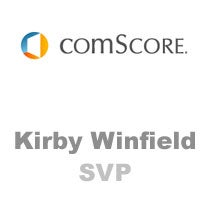 Yesterday, comScore announced its Validated Campaign Essentials (vCE) product which marks the next evolution in integrating AdXpose into its product line devoted to ad effectiveness. AdXpose was acquired back in August for $22 million (AdExchanger Q&A).
Yesterday, comScore announced its Validated Campaign Essentials (vCE) product which marks the next evolution in integrating AdXpose into its product line devoted to ad effectiveness. AdXpose was acquired back in August for $22 million (AdExchanger Q&A).
The release states that vCE provides a “view of campaign delivery and a verified assessment of ad-exposed audiences via a single, third-party source.” Furthermore, according to the company, the new product looks at “a variety of dimensions, such as ads delivered in-view, in the right geography, in a brand safe environment and absent of fraudulent delivery.” Read the release.
Kirby Winfield, SVP, Corporate Development at comScore and former CEO of AdXpose, answered questions regarding the announcement.
So, is [yesterday]’s announcement essentially the next gen of AdXpose within comScore’s product offering?
It’s quite a bit more than just another version of AdXpose. It’s really what we envisioned when we decided to sell the company to comScore: a one-tag, soup to nuts solution for measuring and validating each impression in an online ad campaign, from the legacy “ad verification 1.0” metrics to the next generation comScore audience and reach/frequency metrics. This collaboration inspired our combined tech and research science teams to come up with the Validated GRP (vGRP), which finally tackles the huge problem of inaccurate reach and audience measurement head-on.
What is a vGRP?
A vGRP is analogous to the traditional online GRP except that it only accounts for ads that were delivered in-view, in the right geography, in a brand-safe environment, and absent of fraudulent delivery. Essentially, the vGRP measures the impressions that can actually have an impact on the consumer. There is also a vTRP, which takes into account whether the validated impressions were delivered against their intended audience targets.
Why should marketers, and publishers for that matter, care?
Every company in the digital advertising business has until today had a fundamentally inaccurate basis for calculating reach and frequency online. Essentially, if you count an impression that gets delivered but is unviewable as having “reached” an audience, you’re exponentially undervaluing the true ROI of your online spend. Put another way, if 40% of your ad impressions are invalid, your true reach/frequency is less than you think it is by an order of magnitude.
Because this has not been measurable previously, premium publishers have been punished by the glut of lowest-common-denominator, unviewable placements dragging down overall industry CPM’s and performance. Brand marketers scratch their heads and wonder why their online spend delivers surprisingly low ROI/brand lift – it’s because their true validated GRP is almost 50% less than their unvalidated “delivered” GRP! Your online is far more effective than you think, if you price and purchase according to actual value. This adjustment solves the current supply/demand imbalance, and should create a virtuous cycle of increased performance and higher CPMs.
How do you see the product evolving down the road?
I think one of the best things we as a measurement standard can achieve is starting to steer the conversation around online or digital advertising towards a common language with offline, especially as the lines between the two continue to blur. The next step is to make that conversation global; we will be rolling out the vCE product internationally over the coming months. Beyond that, I am really passionate about bringing real time, SaaS technology to the traditional digital research world. I think we will do whatever it takes to help automate and standardize valuation and measurement of media. So RTB and platform integration are also steps we’re taking on the product side.
Ultimately, the product’s continued evolution will be a function of how the ad landscape evolves and what the market demands. One of vCE’s key benefits is that it introduces simplicity to what has become an inordinately fragmented and chaotic environment. If we’ve learned anything from the evolution of digital advertising over the past few years is that there will be more innovation and that it will bring with it even more complexity to the value chain. Our vision for this product will be to continue to provide an elegant solution that makes measurement simple no matter how complex the rest of the system may become.
And you – what is your role and responsibilities these days at comScore? Any key challenges being part of a larger, public company versus the startup world of AdXpose pre-acquisition?
I always joke that the biggest challenge has been fitting in to the suits I had left over from my last public company gig. But actually, we’ve been fortunate to integrate pretty seamlessly into the comScore organization, from a product, development, and sales perspective. That leaves former AdXpose COO Ryan Polley and I to tackle new challenges, so we’ve created an initiative to drive adoption and integration of comScore data and technology into digital ad platforms, servers, and systems as an ingredient of everything from audience buying to RTB bid optimization. At the end of the day, the information we provide should be accessed by people and systems in each link of the ad value chain, in real time. We want to enable the next huge tranche of online ad growth by making measurement simple, transparent, accurate and actionable.
By John Ebbert













